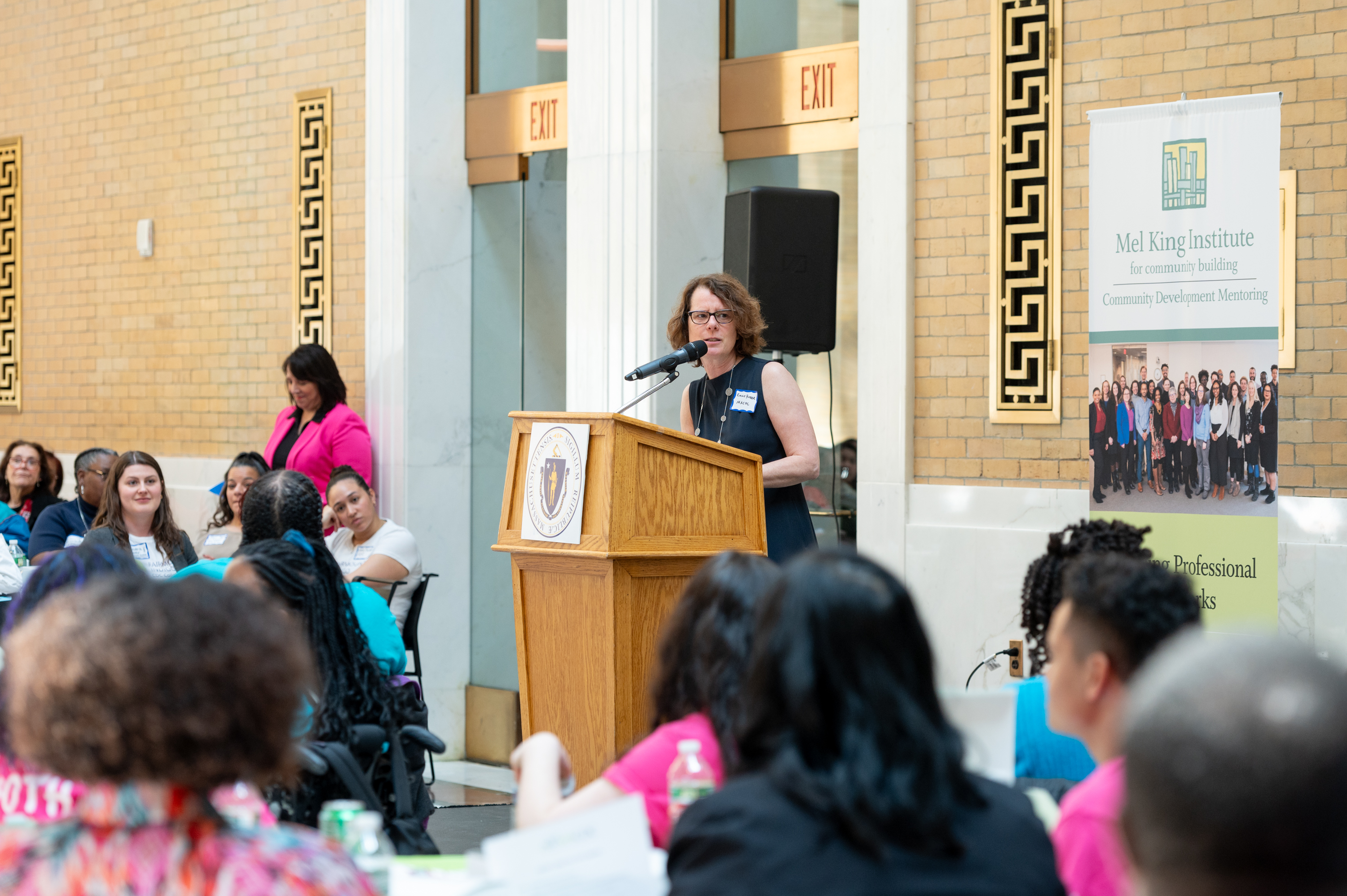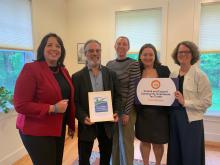For the past year, MACDC’s Boston Committee has been working with the Massachusetts Minority Contractors Association (MMCA) to sponsor the Boston Pilot Program, a joint effort to help six Boston CDCs increase their utilization of minority and women owned enterprises (M/WBEs) on 11 separate real estate projects across the City of Boston. The program established the goal of ensuring that at least 30% of the work was done by MBEs and 10% by WBEs. As of June 30, six of the projects were in construction and the other five were in various stages of pre-development. So far, the projects have contracted for slightly more than $95 million in hard and soft costs, with 36% of the total going to MBE’s, 9% going to WBE’s, with a total of 41% going to either a MBE or WBE (the numbers do not add up because we do not double count minority-women-owned businesses). This means that the CDC-sponsored projects have generated a total of nearly $39 million in economic opportunity for minority- and women-owned businesses, with much more to come as these projects continue to move forward. Working with MMCA, we will continue to try to hit the 10% goal for WBE participation and try to increase the MBE numbers for soft costs where the percentage is much lower (MBE’s earned 41% of the hard costs, but just 13% of the soft costs; WBE’s were at 9% for both hard and soft costs).
News
DOR Finalizes CITC Regulations
July 30th, 2014Recently, the Massachusetts Department of Revenue finalized its regulations for the Community Investment Tax Credit (CITC) program. These regulations define qualified donations (investments) to a Community Development Corporation or the Community Partnership Fund. The regulations also explain the benefits of the program and highlight some important key points for donors:
- Donors can choose to donate directly to a CDC designated as a community partner (i.e., a CDC with tax credits to allocate to donors) or they can choose to donate to the Community Partnership Fund, for which the United Way of Massachusetts Bay provides administrative support.
- Donors do not need to live in Massachusetts or have any Massachusetts income tax liability in order to make a donation and receive the tax credits. If a nonresident makes a qualified donation, he or she can file a MA nonresident tax return to claim the refund.
- Nonprofits registered as 501c3 organizations may contribute to a community partner and receive a tax credit (if the organization has unrelated business income) or a refund.
- Contributions to CDCs through a Donor-Advised Fund (DAF) are allowed. However, the tax credit or refund would be applied to the nonprofit or foundation administering the DAF, not the individual or family who established the DAF. The nonprofit or foundation managing the DAF can put the money back into the DAF, but cannot give it back to the individual or family that set up the account.
Please make sure you consult your tax advisor.
For more information on the CITC program, please visit MACDC's CITC website.
Community Development Partnership Announces Launch of Winter Farmers’ Market
July 30th, 2014The Community Development Partnership (CDP) recently announced the launch of the first ever Winter Farmers’ Market on the Lower Cape, which will open in December. The Orleans Winter Farmers’ Market will take place at the Nauset Regional Middle School on the first and third Saturdays of the month from 10 AM to 12 Noon, beginning on Saturday, December 6th and ending April 18, 2015. A project of the CDP, the Market is offered with support from the Orleans Winter Farmers Market Advisory Committee and made possible by financial support from the USDA Rural Development Program and the Cape Cod Economic Development Council.
CDP made the announcement in preparation for National and Massachusetts Farmers’ Market Week, commemorated from August 3rd to August 9th. This year marks the 15th annual National Farmers' Market Week, recognizing the important role that farmers’ markets play in the agricultural and food economy. The U.S. Department of Agriculture began declaring a National Farmers Market Week in 2000. Since then, the number of Farmers’ Markets nationwide has almost tripled, from 2,863 markets in 2000 to 8,144 in 2013. Massachusetts has seen similar growth, now counting more than 250 markets across the Commonwealth. Cape Cod has 17 markets open this summer, which is more than double the number of markets from six years ago and its greatest number of markets ever.
“Farmers’ Markets have a long history of fueling economic development and adding vitality to the communities in which they are held,” said Jay Coburn, Executive Director at the CDP. “We are incredibly excited to be working with local growers and food producers to help them grow their businesses and create opportunities for year-round sales. And we can’t wait to show Lower Cape residents that it is possible to grow fresh and nutritious food on Cape Cod 12 months of the year.”
Wellfleet Farmers’ Market Co-founder and member of the Orleans Winter Farmers’ Market Advisory Committee, Tracy Plaut, commented about the new Market, "Being able to supply fresh, locally raised food to the community keeps our friends and neighbors healthy, as well as building a strong and vital economy. It's a pleasure to support the ever-growing number of farmers who make their living while facing the many challenges of growing on Cape Cod."
Applications are still being accepted for vendors interested in participating in the Orleans Winter Farmers’ Market. Market vendors will also have access to business workshops targeted to growers and producers, as well as individualized technical assistance. More information for vendors and the Public is available at the CDP’s website. Information will be updated over the next few months, including participating vendors, featured musicians and special Market demonstrations.
The Community Development Partnership (CDP) nurtures a vibrant Lower Cape region – Brewster, Chatham, Eastham, Harwich, Orleans, Provincetown, Truro and Wellfleet - by promoting environmental and economic sustainability, expanding opportunities for low- and moderate-income residents, and preserving our unique cultural and historic character.
MACDC Interviews Governor Patrick
July 24th, 2014On Wednesday, July 23rd, MACDC's President Joe Kriesberg sat down for an interview with Govenor Deval Patrick to talk about the Community Investment Tax Credit, why he signed into law this program and why CDCs are so important to all communities across the Commonwealth. Check out the complete interview below!
CLICK HERE to view video.
Advice for CITC Donors and CDCs
July 17th, 2014In a recent article, Accounting Management Solutions (AMS) offers advice to CDCs expecting donations through the CITC program. According to AMS, organizations should be careful not to count the tax credits themselves as revenue. Until an organization receives a contribution for which tax credits are issued to the donor(s), the revenue is still considered conditional; once a donor exchanges their donation for the tax credits, then revenue can be recognized and counted. To read the full AMS article, click here.
AMS is a leading resource for outsourced accounting and financial management services in Boston and New York City.
CITC Provides Dual Opportunity for Community Impact and Tax Savings
July 10th, 2014FY15 Housing Capital Budget Increased by $11 Million
July 10th, 2014Massachusetts Governor Deval Patrick released his capital budget for Fiscal Year 2015, and the Housing Capital Budget is increased by $11 million over the FY14 amount, now totalling just over $190.5 million. The capital budget for privately-produced housing (not including public housing) is now at just over $100 million, the first time it has reached this milestone in the eight years of the Patrick Administration. This is good news!
For FY15, there are significant increases for the Housing Stabilization Fund, the Housing Innovations Fund, the Facilities Consolidation Fund, and the Home Modification Fund. MACDC, in collaboration with CHAPA and our allies in The Building Blocks Coalition, have long advocated for an increase in the Capital Budget and we are very pleased to see such a significant increase this year. It will directly result in the production of more housing for families who desperately need it.
Click here for a spreadsheet with the detail of the FY15 budget, along with a comparison of how the housing capital budget has varied over the past eight years.
The State of the Nation's Housing
July 10th, 2014On June 26th, Harvard University's Joint Center for Housing Studies (JCHS) released the 2014 State of the Nation's Housing report, during a live webcast. The report, released annually by JCHS since 1988, includes a current assessment of the state of the rental and homeownership markets; the economic and demographic trends driving housing demands; the current state of mortgage financing; and issues with ongoing housing affordability.
According to the report, the housing market is still on track to recover, but faces significant challenges, and millenials will be the key to a stronger recovery. Overall, the housing market's growth and improvement mirrors the broader economy: slow and steady. Among the key points highlighted in the report:
- Tight credit, higher mortgage interest rates, stagnant incomes and rising student loan debt are tempering the growth of the housing market and keeping many young Americans from purchasing a home.
- As millenials age, the demand for housing should grow, and the next generation of homebuyers will be the most diverse in the nation's history, as miniorities represent a growing share of the homebuyer market.
- Demand for rental housing remains strong, with an increase in the development of rental properties, but the cost burdens of housing are particularly high for renters. More than 35% of Americans are cost burdened when it comes to housing, meaning they spend more than 30% of their income on housing costs. Approximately 50% of renters, however, are cost burdened, with nearly a quarter of renters severely burdened (paying more than 50% of income on housing).
- Supplying housing for low-income and extremely low-income families continues to be a challenge. The primary barrier for these families is availability - there is a significant gap between the number of low-income and extremely low-income families needing a home and the number of affordable homes available to them.
The full report, with all the data and conclusions, along with an executive summary and interactive maps, are available on JCHS's website. The State of the Nation's Housing report has earned national recognition as an authoritative source of information on the housing market, routinely referenced by researchers, analysts, policy makers, and the larger community.
CTI and Merrimack Valley Small Business Center Help Fund Start-ups
July 9th, 2014On Friday, June 27, the Merrimack Valley Small Business Center (MVSBC), a program of Community Teamwork, announced that it had been designated as an intermediary for the SBA (Small Business Administration) Microloan Program, with approval for $200,000 in loan funds to support small businesses throughout the Merrimack Valley.
“Local small businesses now have an additional access point for SBA microloans and the technical assistance this program offers,” said SBA District Director Bob Nelson. “This is excellent news for small businesses and for the local economy and we are confident that the Merrimack Valley Small Business Center is going to be a phenomenal resource.”
The MVSBC approved its first SBA-funded microloan to the Food Train, a Haverhill-based startup business and the first food truck operation to be established in Haverhill. Slated to open this month, Food Train owners Thomas and Tiffany Bell have been working with the MVSBC staff since early 2014 to complete a thorough business plan and loan application, which was approved in May in the amount of $14,000.
“When Thomas and I were turned down by multiple banks for conventional loans to start our business, we turned to the MVSBC. From our very first meeting, we knew that finally we were working with people who believed in us and our dream,” said Tiffany.
MVSBC Director Liliana Kualapai and Haverhill Mayor James Fiorentini both expressed their thanks to the SBA Microloan Program for supporting the Bell family’s dream and helping sustain local small businesses. In addition to Director Kualapai and Mayor Fiorentini, other officials on hand to publicize and celebrate this program included Congresswoman Niki Tsongas, Deputy District Director Anne Hunt of the Small Business Administration, Community Teamwork Executive Director Karen Frederick, and State Representative Linda Dean Campbell.
“In order to boost job growth and continue growing our economy, we need to invest in creative ways to help America’s small businesses,” said Congresswoman Tsongas. “I have long supported federal programs like the SBA’s microloans because they can accomplish this goal through effective public/private partnerships. With this federal support, the Merrimack Valley Small Business Center and Community Teamwork will further their important mission to support the local small business community. By pinpointing and addressing the differing needs of the many small businesses across our region, we can keep our local economy on an upwards path.”
“Thomas and Tiffany Bell of Haverhill’s Food Train are just the type of determined entrepreneurs this support is meant for, to help them make their dream a reality. There are so many inventive companies clustered throughout the Third District developing imaginative and state-of-the-art products and services in myriad industries. With federal, public and private support, we can ensure they don’t just remain competitive, but remain business and innovations leaders.”
For more information about Community Teamwork's programs, please visit their website.
Making Campaigns Matter
June 24th, 2014An Op/Ed Column by Joe Kriesberg, MACDC's President
As this year’s gubernatorial campaign heats up, community developers, like others, are beginning to focus on the different candidates and considering what this election will mean for our field and our communities. Many non-profits, including MACDC, want to do more than simply observe the process and speculate on the outcome. We want to engage and shape it. But how can we do that? As non- profits, we cannot endorse a candidate; and no matter who wins, we have to work with the new Administration. Indeed, during my time at MACDC, I have worked closely with five different Administrations (Weld, Celluci, Swift, Romney and Patrick) and fully expect to work successfully with a new one next year regardless of who wins.
But political neutrality does not mean that we should sit on the sidelines. Campaigns don’t just determine who will govern, but they also shape how the winner will govern. Campaigns help identify the top tier issues for the next Administration and campaigns often generate promises and commitments from all the candidates, including the eventual winner. Do they keep all of those promises? Of course, not. But do their campaign promises influence their behavior after the election? Absolutely.
In 2006, Governor Patrick, and two other candidates for Governor, came to the MACDC convention at the Hynes Convention Center on October 14. At a candidate forum moderated by Pam Cross from WCVB, we asked each candidate three questions: (1) Would s/he fund the Affordable Housing Trust fund at $40 million? (2) Would s/he fund the state’s newly established Small Business Technical Assistance program? And (3) Would s/he enact legislation to preserve expiring use properties? Candidate Patrick said “Yes”, “Yes”, and “Maybe”. He expressed skepticism about expiring use legislation and whether it would be fair to both owners and tenants, but he promised to listen and to work with us to explore possible solutions. (Side note: We did not ask about the Community Investment Tax Credit because we had not even come up with the proposal yet!)
So what happened? In his first capital budget, the Governor proposed just $35 million for the Affordable Housing Trust Fund. After a short, but vigorous response from the housing community, he quickly restored full funding. I can assure you that his campaign promise was a big reason for the quick turn- around. He then funded the Trust Fund at $40 million for the next seven years.
With respect to the Small Business program, the Governor kept funding the program even as the state budget crisis unfolded during the recession. He kept the program alive by funding it “off-budget” through the Mass Growth Capital Corporation and then this year he helped secure a $2 million appropriation from the legislature, restoring the program to full funding: 8 years of funding – just as he promised in 2006.
Expiring use legislation was harder, but the Governor kept his promise and listened to the views of all stakeholders and then helped to fashion a compromise bill that was enacted in 2007 as MGL Chapter 40T. This law has now helped to preserve nearly 10,000 homes as affordable housing.
Three for three, by my count.
MACDC is thankful that Governor Patrick kept these commitments and we know it reflects his commitment to these issues. But we also know that a Governor has to balance hundreds of competing priorities, so we were glad to help the Governor fulfill these commitments by working closely with his Administration (and the legislature) throughout the process. In other words, campaign commitments matter, but they don’t complete the task. Advocates have to stay with the process after the election too.
So as the 2014 campaign heats up, MACDC and its members and allies need to engage the gubernatorial candidates. The MACDC Board of Directors has already met with six of the candidates (Baker, Berwick, Coakley, Falchuck, Grossman and Kaymen) to have thoughtful discussions where we were able to introduce them to the CDC field, learn about their priorities and discuss important issues to our communities. We are now cosponsoring a major Candidate Forum on Affordable Housing with our colleagues at CHAPA and throughout the housing field on July 9 at 2:00 at Faneuil Hall. And on October 25, 2014, MACDC will host another convention, this time at the Westin Hotel in Back Bay, where we expect to hear from all the candidates who make the final ballot.
What questions should we ask them this time? What commitments will they make? Which ones will the next Governor keep?
My plea to community developers and nonprofit advocates around the state: Don’t just wait to see what these answers are. Get involved and help shape the answers.
I hope to see you on July 9 and October 25. And most of all, plan on voting on November 6, 2014.









